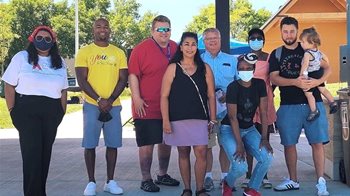 Since 2020, the METRO Blue Line Extension project has extended the reach of their public involvement staff by directly contracting with up to 15 community and cultural groups throughout the various phases of project planning. Project staff recognize the value of these groups’ experience, expertise, and trusted relationship networks, especially with low income communities and communities of color in the corridor. These groups also played an invaluable role with community engagement during the difficult times of COVID-19 and civil unrest.
Since 2020, the METRO Blue Line Extension project has extended the reach of their public involvement staff by directly contracting with up to 15 community and cultural groups throughout the various phases of project planning. Project staff recognize the value of these groups’ experience, expertise, and trusted relationship networks, especially with low income communities and communities of color in the corridor. These groups also played an invaluable role with community engagement during the difficult times of COVID-19 and civil unrest.
Hennepin County, as a key partner in the project, contracted with these groups to conduct direct engagement with culturally appropriate strategies such as hosting community meetings and focus groups, tabling at pop-up events, door-knocking, surveys, translation reviews, videos, graphics, Facebook live events, and cultural performances. Additional deliverables included advising on project communications, amplifying project communications to a variety of community-based social media networks, documenting, and reporting out community feedback, participating in monthly cohort meetings, and submitting final reports at the end of each phase of engagement.
Throughout this time, project staff implemented a community feedback loop system for the cohort during monthly check-in meetings:
- Cohort members receive timely accurate information on project updates
- Cohort members report out on events and activities that they are conducting
- Cohort members report out on what they are hearing and learning from community
- Project staff hear about community issues and opportunities monthly from the cohort
- Project staff discuss community issues and opportunities at their weekly project meetings in an iterative consideration with design and engineering, station areas, environmental study, communications, and anti-displacement initiative
Direct outcomes from these cohort members include the inclusion of the anti-displacement initiative, design and engineering considerations, identifying community and cultural resources, communications approaches and strategies, 3-D models created by youth apprentices, and an extensive list of community issues, concerns, and opportunities.
See the latest cohort activities
Phase 1
Cohort organizations were selected by geography and cultural groups represented. Based on corridor demographics, these cultural groups were identified in the Phase 1 of the cohort. The four-month Phase 1 period included three cohort members that made recommendations for how to conduct future community engagement using stakeholder analysis and focus groups. The Phase 1 cohort gathered information about key stakeholders, cultures, and community engagement methods, including educating corridor residents about the new direction in the route of the project.
Phase 2 and 2.5
Phase 2 had a wider reach of cohort members who focused on the continued education of the new direction while collecting community input leading up to a Route Recommendation Report. In Phase 2.5, six more months of engagement were required to come to a final draft of the Route Recommendation Report, with a priority focus on the area most change in North Minneapolis.